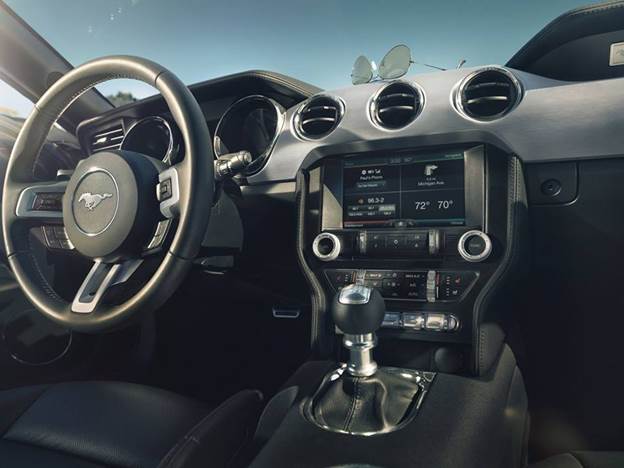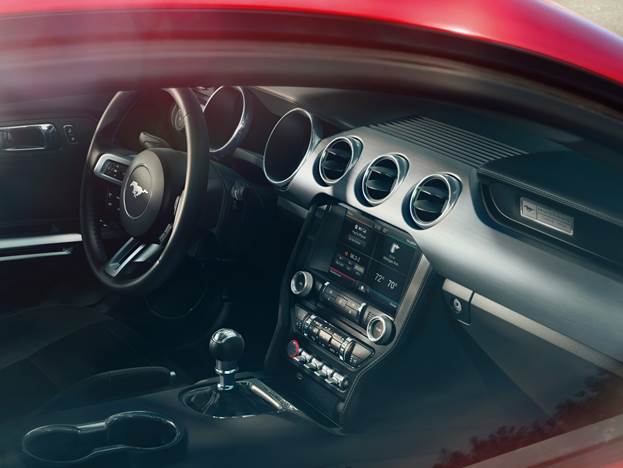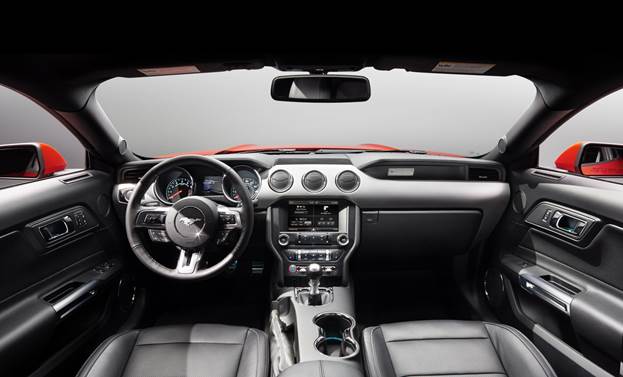The ’15 Mustang’s airplane-inspired cockpit makes a statement
In the world of automobiles, it’s the car’s exterior that makes the big first impression. That’s not to say we are all superficial, but when it comes to cars, we want to like the way our ride looks. Its appearance says something to the world about us.
However, when you get down to it, the interior is where we spend our time. A Mustang’s cabin provides an escape from the real world, but it can also be a source of adoration or annoyance.

In recent years, interiors have been an area of emphasis around the Blue Oval, but in the Mustang, the guts are always overshadowed by the sheetmetal and drivetrain. That may just change when you finally get behind the wheel of the latest Mustang.
If you can’t already tell by looking at these photos, Ford’s designers put at least as much effort into creating a purposeful, stylish cock-pit from which to pilot a vehicle of this caliber as they did on the rest of the vehicle. To do so, the team fused research, design, and innate Mustang knowledge to bring the interior to this level, but that was made easier because these passionate people really do work as a team.

“Dave [Pericak] and I have worked together for a long time. We have a close personal relation-ship as much as we do a working relationship. So we have gotten along well from the beginning,” said Doyle Letson, chief designer Global Interiors. “When I knew he was going to be the chief and I was going to be the chief, we said we are going to deliver a car, and that’s the way it went. Numerous times, instead of going through all the meetings that you have to go through, we would sit down in a room and say, ‘Hey, this is what we have to do. What’s gonna be the best thing to do?’ And make a decision and move on with it.”
With a solid idea of what Mustangs need and a few sketches in hand, Ford designers turned right to focus-group research to get a sense of what customers desired.
“We know Mustangs really well. We sit down and we brainstorm. What does the vehicle need to have? What do we need to do with this one? It’s the 50-year model, so we need to make sure it’s great,” Doyle said. “What we learned from this,realistically, from the first market research was four inviolables that you could not leave out of the interior. One of them was round analog gauges – large, round analog gauges. They wanted the instrument panel to be symmetrical. They wanted a symmetrical feel to the interior. They wanted the symmetrical double brow on the instrument panel. And, they wanted premium authentic materials.”

With those inviolables in mind, Doyle and his team went to work with a clear direction in mind.
“That kind of locked us into what we were doing with the aluminum. We started thinking aluminum. We started thinking aircraft, and that kind of steered us a bit and got us a little more focused as we continued on to the development phase.”
“We ended up with basically two themes toward the end that we ended up merging. One of them I considered to be a little more evolutionary and the other more revolutionary,” Doyle said. “We ended up going with the revolutionary, but picking up a lot of the evolutionary theme, which was a little bit more sophisticated and a little bit more luxurious.”
That revolutionary theme was based on the purity of mission found in race-car interiors and airplane cockpits.
“You look at racing; you get inside a race car. You get inside a rally car and the interior is stripped out. What you have there is just the business. It’s the stuff that’s really there for a reason. It’s there for a purpose. Everything is within reach, and it’s all about driving the vehicle,” Doyle added. “That’s kinda how we got into the cockpit thing. It’s all about flying the plane. When we were going through the development of the interior instrument panels, one of them took on a wing shape. That’s what set up everything. We started thinking about what happens in the cockpit. You have this beautiful wing, and one thing transferred into another.”

Having not yet driven this car, we can’t say exactly how this interior works in the real world. However, we did sit in a full-size model and came away impressed by both the appearance and ergonomics of this cabin. The interior is also distinctly Mustang. It shares little in the way of corporate interior DNA. It is unique to Mustang – and it is good.
“We’ve made a conscious effort over the past few years to really focus on interiors and create some new, exciting designs that are well put-together, well thought-out, and well designed – not styled,” Doyle said.